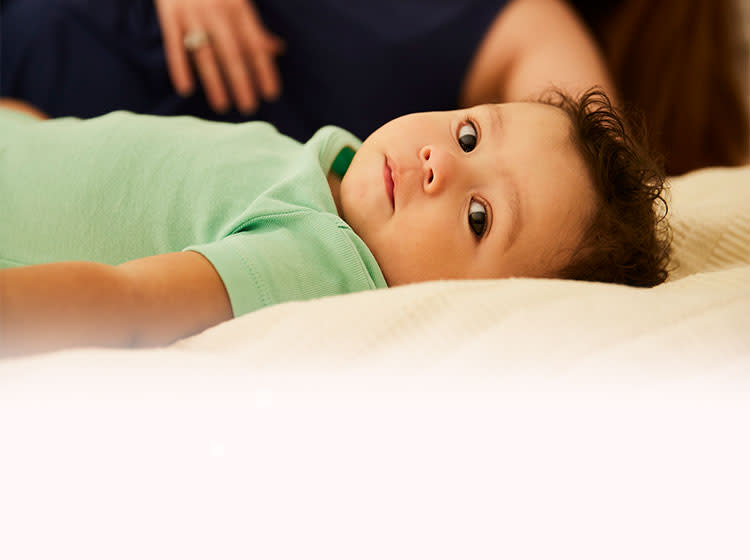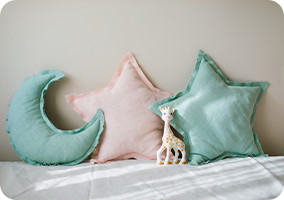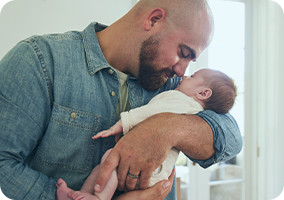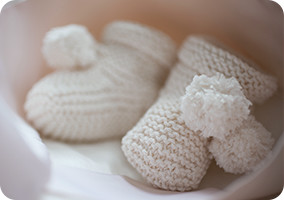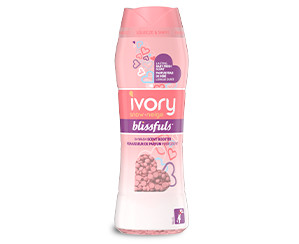When to Start Babyproofing Your Home
Safety preparation for baby begins as soon as you start buying baby items and setting up space for them in your home. Some of the first items expectant parents buy are below.
Newborn onesies with hand covers to prevent self-scratching
Baby laundry detergent for sensitive newborn skin
Night lights to avoid bumped knees and shins
Sound machine for more soothing sleep
These are just a few of the first steps, but many parents will also take this time to identify potentially hazardous furniture, sharp corners in a room, or door hinges that can pinch as they anticipate and prepare for their new arrival.
Before baby arrives is also the perfect time to tackle bigger home issues like broken windows, fixing smoke detectors, and setting the max temperature on your hot water heater to 120 degrees Fahrenheit to avoid scalding baths.
The real baby proofing of your home should begin in earnest as soon as your child can sit and roll over on their own. As they begin to move around and explore, it will be vital for you to have already done your homework to prevent injury or damage.
Once your little one is in the 6-10 months age range, they will begin crawling and possibly walking. Parents who may have started baby proofing the house during pregnancy should recheck their preparations, adjusting and making new ones as they go.
Baby Safety in Your Home
It’s easy for adults to ignore potential baby hazards that lurk within their own homes. Your baby will explore every inch of any space you allow them to roam. We recommend you do a room-by-room baby proof house checklist, carefully evaluating any space where your baby will spend time. Don’t be afraid to get down on hands and knees to see things from a baby’s perspective. You may be surprised. Counter overhangs, thick carpet, and space underneath furniture are all areas that can hide choking hazards like paper clips, loose change, or other small items.

Checklist for Babyproofing Your House
Living Room and Common Areas
The living room, den, or common area is where many families gather most frequently. The living room may be where your family gathers to watch television or simply spend time together. As you evaluate the safety of your common areas, be sure to keep an eye out for these hazards.
Sharp corners, edges, or exposed brick
Exposed electrical outlets
Tippy furniture
Exposed radiators
Stairs
Exposed cords and wires
Fragile electronics, glassware, or other breakable items
Fireplace and/or brick hearth
Blinds with hanging cords
Steps you can take to baby proof a common area:
Electrical outlet covers
Cover any radiator or fence it off
Cable routers and covers for any exposed wiring
Baby gates to prevent your child from wandering into other spaces
Padded adhesive covers for corners or exposed brick
Hearth cover and/or gates for your fireplace
Anchoring hardware to secure tippy furniture to walls
As you approach baby proofing your common areas, keep in mind how your family prefers to use this space and plan accordingly. Fireplaces, televisions, and unstable furniture are all potentially dangerous to your child. Hanging cords from any blinds are strangulation hazards and will need to be adjusted out of baby’s reach. You will also need to ensure fragile items are out of reach, cables and wiring are hidden, sharp corners are covered or fenced off, and tippy furniture is anchored securely to walls.
Stairs can also be a falling hazard for children, so if your home has stairs, be sure to block them off with gates at both the top and bottom to keep her from going up or down on her own.
Nursery
Next to your family’s common area, you’ll spend lots of time in your baby’s nursery, especially in the first 6 months. In your baby’s nursery, look out for these potential hazards.
Exposed electrical outlets
Tippy furniture
Blinds with hanging cords
Door or closet hinges that can pinch little fingers
Hard floors or sharp corners
Steps you can take to baby proof a nursery:
Electrical outlet covers
Nightlights to avoid bumps in the night
Pinch guards on exposed hinges
Adjust any blind cords so they are out of reach
A thick padded rug to protect from falls or trips
Padded adhesive covers for corners or sharp edges
Diaper pail to avoid baby exploring dirty diapers
Additionally, be sure changing tables, cribs, and chests of drawers won’t tip over, cover any electrical outlets, and try to avoid hanging any decor that your baby might be able to pull down on top of them. Keep in mind that just because they may not be able to reach it now, it’s only a matter of time before they can.
Kitchen
In addition to being the area where families prepare their meals, the kitchen is frequently a space where cleaning supplies for the home are stored. Many of these chemicals are colorfully labeled and pleasantly scented, so they will naturally attract a curious baby’s attention. Below is a list of things to look out for and secure in your kitchen.
Cleaning supplies and other toxic materials
Stove burner knobs
Dish washer buttons
Tablecloths
Dishes and glassware
Small appliances
Trash cans / recycling bins
Cabinets and drawers that contain pots, pans, or sharp utensils
Steps to take to baby proof a kitchen:
Door and cabinet locks, especially for toxic cleaning supplies
Doorknob covers
Stove knob covers
Garbage can covers with locks
Since many of the items in your kitchen are used multiple times daily, baby proofing in this space is ongoing and parents must remain vigilant. When possible, move glassware, knives, and toxic cleaning chemicals hidden up high, well out of reach of curious little hands. Be sure to avoid things like tablecloths or easy-to-open trashcans where babies might be able to pull things down on top of them or open potentially hazardous garbage.
Bathrooms and Laundry Room
Next to your kitchen, the bathrooms and laundry room of your home can also be spaces where dangerous chemicals and medications lurk, so it’s always wise to evaluate them regularly for potential hazards. Some things to look out for in these spaces are below.
Access to cleaning supplies like tub cleaners, toilet bowl cleaners, or laundry detergent
Access to toilets or bathtubs that may hold water
Access to medications and adult hygiene products
Exposed knobs and spigots that may present sharp metal edges
Shower curtains that can be grabbed or pulled
Hot items like hair dryers or curlers
Items to buy for baby proofing a bathroom and laundry room
Toilet locks
Soft covers for tub spouts and knobs
Non-slip bathmat to prevent slipping with wet feet
Shelving or cabinetry to hide detergents, cleaning supplies, and medications up high and out of baby’s reach
The cleaning supplies and detergents you use in your bathroom and laundry room can be toxic to babies, so elevating these items and keeping them hidden from your child’s view are two of the best ways you can prepare these spaces for your little one and keep them safe.
Decks and Porches
During comfortable spring, summer, and fall months, many new parents enjoy spending time with their baby on decks or porches. These spaces frequently offer outdoor views with rails and barriers in place to keep baby within eyesight. When evaluating these spaces for safety, be sure to look out for the following.
Stairs
Loose railing
Worn gate latches
Kiddie pools
Splintering wood
Worn or chipped paint
Grills
Steps you can take to baby proof a deck or porch:
Baby gates to prevent access to stairs
Test railing and gate latches to ensure they’re sturdy
Sand and refinish splintered or exposed wood
Move grilling utensils out of reach and ensure propane or charcoal is hidden
Decks and patios are popular gathering areas when the weather is nice, so don’t forget to evaluate the outdoor space where your family may be spending their time. If you have a small wading pool for your child, always be sure to empty it and store it on its side. Any item, even a bucket, that can hold water is a drowning hazard for babies and toddlers alike.
Safety Guidelines for Infants
Newborn babies are delicate, wonderful little beings, but since they cannot do anything on their own, it’s important for parents to take time to consider how they will keep them safe and comfortable through their daily routines.
Feeding
For the first six months, your baby will either nurse or drink from a bottle every meal. Once they begin taking in solid food, parents should be mindful of the size of the bites they give them, keeping in mind that anything that can fit through a toilet paper tube is a choking hazard. Also keep in mind that the molars adults use to grind up food don’t come to most babies for over a year, so there may be some foods they love that they cannot chew. Foods to be mindful of as your baby begins eating are below.
Grapes and blueberries (cut these into quarters)
Hot dogs (halve these down the middle and slice into small pieces)
Nuts (these can be an allergen as well as a choking hazard, so introduce these to baby very carefully)
Meats (ground, when possible, will be easier for baby to consume)
Bathing
When baby first comes home, she will be tiny enough to bathe in your sink, but don’t get used to it! She will quickly grow into a curious little being, eager to splash and blow bubbles in her bathwater. Below are some steps you can take to ensure bath time remains safe and happy.
Check your water heater’s thermostat and ensure max temp is no higher than 120 degrees Fahrenheit
Never leave your child unattended in a tub that has any amount of standing water
Move all soaps, shampoos, and cleaners up and out of baby’s reach; these can be toxic for babies, so don’t leave them on the edge of the tub
Pets
Pets can be a great way to introduce your children to animals and the responsibility of caring for another living creature, but care should be taken to consider your pets feelings and prevent unwanted bites or scratches.
Move pet food and water to its own space, well out of access of your child. Pets can be protective of their food and may snap at curious little hands if given the chance.
Keep pet toys out of reach of children as pets can be possessive of these as well.
Dog and cat doors should be secured to prevent baby access.
FAQs about Baby Safety and Baby Proofing
Although baby proofing can seem exhausting and never ending, once you’ve completed your initial baby proofing checklist, it will only take a bit of your time here and there. As your child grows, they will learn with your guidance to protect themselves from potential hazards in your home. But if you’re still feeling overwhelmed, you can view a downloadable checklist of babyproofing steps for your home here.

